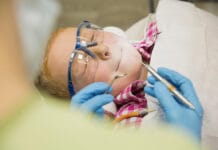Contaminated surfaces, instruments, and airborne particles present in dental and medical settings are a potential health hazard to medical professionals and patients. Although these microbial populations can be minimized through preventive efforts such as pre-procedural rinses, plastics barriers and proper infection control, these microorganisms are still present in the operatory. Sterilization has been thoroughly studied for use in many medical settings and surfaces, but airborne microbes have always been a perplexing area of research. Even though all surfaces and instruments have been sterilized, the air is always a silent contaminator.
Recently, an innovative way to eliminate airborne microbial populations was found through interfering with parts of microbial DNA.
Ultraviolet Germicidal Irradiation (UVGI) is a sterilization method commonly used in hospitals and medical settings to destroy airborne microorganisms. UVGI is most often utilized as a lamp in the operating room for air purification or a lighted box for toothbrush sterilization. This method of sterilization has increased due to its efficacy and ease of use—only lasting a 15-minute duration and typically costing two cents per cycle3. Ultraviolet Germicidal Irradiation has been used for many sterilization efforts since the mid-20th century, but recently has been used for air sanitization as well as the sterilization of equipment, instruments, operating room2 and toothbrush disinfection3.
UVGI works by communicating with the DNA of bacteria. A short ultraviolet wavelength is used to disrupt microbial DNA by destroying the nucleic acids and removing the reproductive capability2. The germicidal range of ultraviolet radiation is classified as “UV-C” and is within 100-280nm wavelengths-the peak of this wavelength being 265nm. If the ultraviolet radiation is within this range or reaching the peak, it is then able to disrupt the DNA and therefore able to remove reproductive capability. UV-C radiation is the most germicidal, followed by UV-B and UV-A1. The effectiveness of the ultraviolet radiation is determined based upon the length of exposure and will irradiate resistant microorganisms more than once to break them down2. This means the longer a microbial population is exposed to the detrimental ultraviolet wavelength, more microbes are affected and can be targeted more than once or longer if they show resistance.
Staff and patients can benefit from the UVGI because of fast turnover time, lessened microbial population in the air, cleaner toothbrushes and a low-cost addition to room turnover. In dentistry, Ultraviolet Germicidal Irradiation can be utilized in conjunction with normal infection control, but can also be used while operating the ultrasonic or while operating a slow-speed handpiece, as an added step to ensuring sanitization. Pre-procedural rinses can lessen the microbial count in the patient’s mouth prior to using an ultrasonic or handpiece, but in any event, microbes may still be present. Because of this, using UVGI may help patients feel clean and comfortable in an office, knowing that an extra step was taken to purify the operatory.
Although UVGI has many potential sterilization benefits, unfortunately, it also accounts for several disadvantages. For example, at certain wavelengths and through direct exposure, ultraviolet light can be dangerous to staff and patients. To avoid the potential dangers of sunburns or in extreme cases, skin cancer, the UVGI lamps are often shielded or confined in an environment to limit the exposure to patients and staff2. Another way to avoid this problem is to only turn on the light during the sterilization process and not during an appointment.
Because UVGI is a method that utilizes light waves as its sterilization mechanism, shadows can be created from neighboring objects.
If an object comes in line with the light, anything in its newly created shadow is “hidden” from the germicidal effect. This can be addressed by moving the light to a new space after the initial sterilization effort to accommodate areas that were missed3. Along with this, distance plays a role in the efficacy of the UVGI. The light efficacy decreases the further away from the source the object is, following the rules of the Inverse Square Law. The physics based Inverse Square Law states, “the intensity of an effect such as illumination or gravitational force changes in inverse proportion to the square of the distance from the source4.” For example, traveling two times the distance results in ¼ the strength present at original reference point3. Because of this and the fact that UVGI doesn’t penetrate well through organic materials, a standard cleaning should be a precursor to using Ultraviolet Germicidal Irradiation to ensure the most effective disinfection and sterilization results are met3.
In conclusion, UVGI achieves sterilization by disrupting microbial DNA by reaching the UV-C germicidal wavelength. This DNA disruption eliminates the microbes’ ability to reproduce and therefore a bacteriostatic or sterile environment is met. Though there are few disadvantages to the use of UVGI, the advantages far outweigh them. Ultraviolet Germicidal Irradiation may be a great addition to standard sterilization protocol in a dental office to help better achieve proper infection control in addition to surface disinfection and heat sterilization.
Need CE? Check Out the Self-Study CE Courses from Today’s RDH!
Listen to the Today’s RDH Dental Hygiene Podcast Below:
References
- Reed, N. G. (2010). The History of Ultraviolet Germicidal Irradiation for Air Disinfection. Public Health Reports, 125, 15-27. Retrieved from: https://www.ncbi.nlm.nih.gov/pmc/articles/PMC2789813/
- Ultraviolet Germicidal Irradiation PDF. (2014). Retrieved from: https://www.liverpool.ac.uk/media/livacuk/radiation/pdf/UV_germicidal.pdf
- Ultraviolet Light Disinfection Data Sheet [Fact sheet]. (n.d.). Retrieved from: http://www.clordisys.com
- Inverse Square Law. (n.d.). In English by Oxford Living Dictionaries. Retrieved from: https://en.oxforddictionaries.com/definition/inverse_square_law












